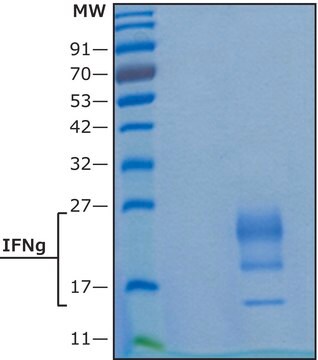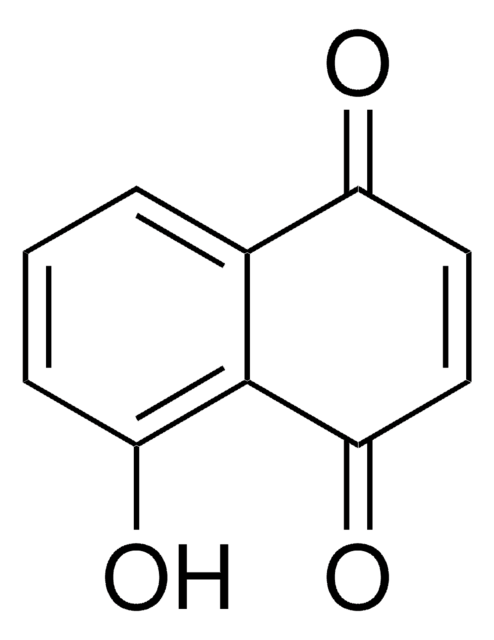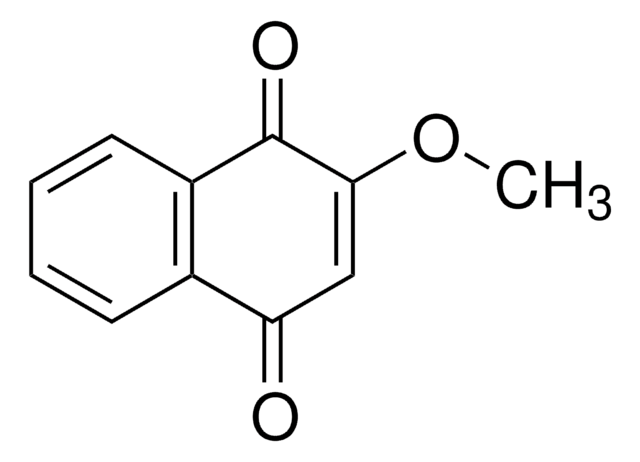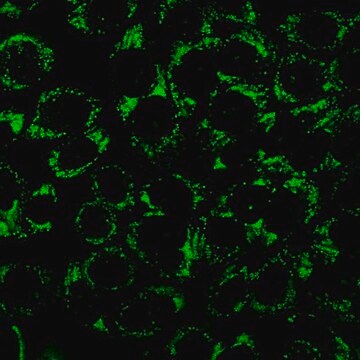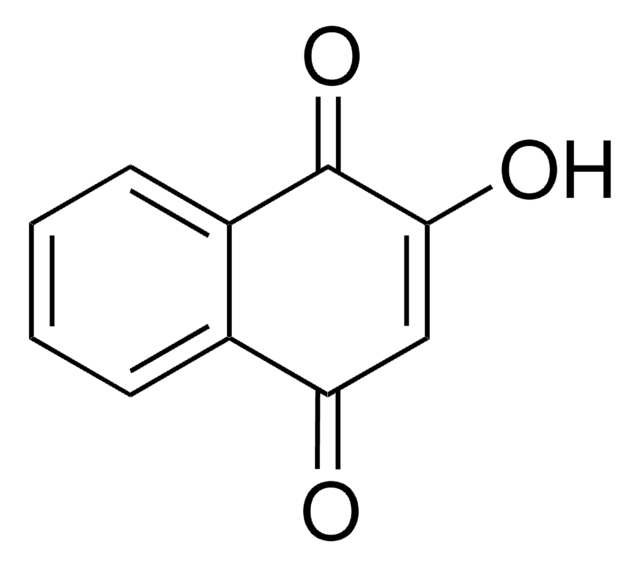D5439
2,3-Dimethoxy-1,4-naphthochinon
≥99%, solid
Synonym(e):
DMNQ
Anmeldenzur Ansicht organisationsspezifischer und vertraglich vereinbarter Preise
Alle Fotos(1)
About This Item
Empirische Formel (Hill-System):
C12H10O4
CAS-Nummer:
Molekulargewicht:
218.21
MDL-Nummer:
UNSPSC-Code:
12352200
PubChem Substanz-ID:
NACRES:
NA.77
Empfohlene Produkte
Qualitätsniveau
Assay
≥99%
Form
solid
Lagertemp.
−20°C
SMILES String
COC1=C(OC)C(=O)c2ccccc2C1=O
InChI
1S/C12H10O4/c1-15-11-9(13)7-5-3-4-6-8(7)10(14)12(11)16-2/h3-6H,1-2H3
InChIKey
ZEGDFCCYTFPECB-UHFFFAOYSA-N
Anwendung
2,3-Dimethoxy-1,4-naphthochinon wurde eingesetzt, um die Wirkungen von Ethanol auf die Podozytenapoptose unter hypoxischen und hyperoxischen Bedingungen zu untersuchen.
Wird zur Untersuchung der Rolle von ROS bei der Zelltoxizität, -apoptose und -nekrose eingesetzt.
Biochem./physiol. Wirkung
2,3-Dimethoxy-1,4-naphthochinon (DMNQ) kann H2O2 durch Redoxcycling erzeugen, kann aber nicht an Glutathion (GSH) konjugieren.
Signalwort
Warning
H-Sätze
Gefahreneinstufungen
Eye Irrit. 2 - Skin Irrit. 2 - STOT SE 3
Zielorgane
Respiratory system
Lagerklassenschlüssel
11 - Combustible Solids
WGK
WGK 3
Flammpunkt (°F)
Not applicable
Flammpunkt (°C)
Not applicable
Persönliche Schutzausrüstung
dust mask type N95 (US), Eyeshields, Gloves
Hier finden Sie alle aktuellen Versionen:
Besitzen Sie dieses Produkt bereits?
In der Dokumentenbibliothek finden Sie die Dokumentation zu den Produkten, die Sie kürzlich erworben haben.
Kunden haben sich ebenfalls angesehen
Acute ethanol induces apoptosis by stimulating TRPC6 via elevation of superoxide in oxygenated podocytes
Lu X Y, et al.
Biochimica et Biophysica Acta - Molecular Cell Research, 1853(5), 965-974 (2015)
Anne R Diers et al.
Redox biology, 1, 1-7 (2013-09-12)
Nitric oxide production by the endothelium is required for normal vascular homeostasis; however, in conditions of oxidative stress, interactions of nitric oxide with reactive oxygen species (ROS) are thought to underlie endothelial dysfunction. Beyond canonical nitric oxide signaling pathways, nitric
Tindaro M Giardina et al.
Biochimica et biophysica acta, 1777(2), 118-129 (2007-12-18)
Uncoupling protein-2 (UCP2) is a member of the inner mitochondrial membrane anion-carrier superfamily. Although mRNA for UCP2 is widely expressed, protein expression is detected in only a few cell types, including macrophages. UCP2 functions by an incompletely defined mechanism, to
Richard Eugene Frye et al.
Scientific reports, 7(1), 4478-4478 (2017-07-02)
Mitoplasticity occurs when mitochondria adapt to tolerate stressors. Previously we hypothesized that a subset of lymphoblastoid cell lines (LCLs) from children with autistic disorder (AD) show mitoplasticity (AD-A), presumably due to previous environmental exposures; another subset of AD LCLs demonstrated
Valerie P Wright et al.
The Journal of physiology, 587(Pt 23), 5767-5781 (2009-10-21)
Skeletal muscles produce transient reactive oxygen species (ROS) in response to intense stimulation, disuse atrophy, heat stress, hypoxia, osmotic stress, stretch and cell receptor activation. The physiological significance is not well understood. Protein phosphatases (PPases) are known to be highly
Unser Team von Wissenschaftlern verfügt über Erfahrung in allen Forschungsbereichen einschließlich Life Science, Materialwissenschaften, chemischer Synthese, Chromatographie, Analytik und vielen mehr..
Setzen Sie sich mit dem technischen Dienst in Verbindung.